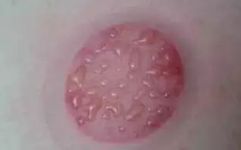★TCM Learning (Massage, Moxibustion, Gua Sha) Video Collection
Cupping therapy is one of the physical therapies in Traditional Chinese Medicine (TCM). Due to poor lifestyle habits, many people today suffer from excessive dampness and coldness in their bodies. Cupping in beauty salons has become popular among customers. Whether experiencing body aches or severe cold dampness, applying a couple of cups can instantly rejuvenate one’s spirit.
 As the saying goes: “Apply a cup, and half the illness goes away!”
As the saying goes: “Apply a cup, and half the illness goes away!”
The cupping method has effects such as promoting meridian flow, invigorating blood circulation, reducing swelling and pain, and dispelling wind and cold. What do the cup marks left on the body indicate about one’s health issues? Let’s explore the “diagnosis through cup marks” together.
According to TCM,
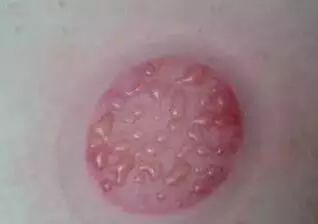
When cup marks show moisture, blisters, or swelling, it indicates that the patient has excessive dampness and coldness, or has been affected by cold and dampness;
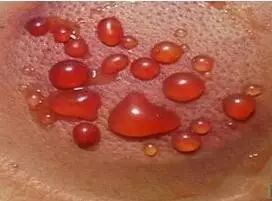
If the cup marks are blood-red or dark red blisters, it indicates a pathological response of long-term illness with dampness and blood stasis;
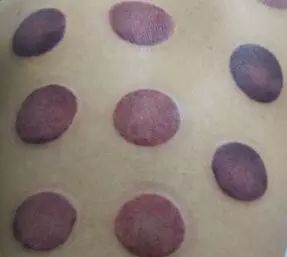
If the cup marks are purple-red or purple-black without stasis or fever, it indicates that the patient has cold and blood stasis, with varying severity;

If the cup marks are purple-red or purple-black, or if there are red spots that are slightly painful to touch, along with body heat, it indicates the presence of heat toxin;
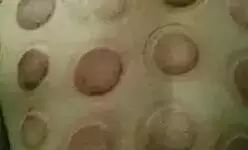 If the cup marks are slightly itchy or show skin lines, it indicates the presence of wind syndrome;
If the cup marks are slightly itchy or show skin lines, it indicates the presence of wind syndrome;

If the cup marks show no color change and feel cool to the touch, it indicates a deficiency of cold syndrome.
-
If after cupping there are no marks or if the marks disappear immediately after removal, it indicates a relatively mild state of sub-health.
-
If the marks do not fade after a few days, it indicates that the condition has persisted for a long time, requiring more attention to treatment and care. As the condition improves, the cup marks will also lighten, indicating recovery.
Diagnosis Methods for Cup Marks in Different Body Areas
After cupping, the skin may show redness, purple-red, or purple-black bruises, small purple-red spots, known as “cup marks.” The appearance of cup marks in different body areas brings different warning signals.
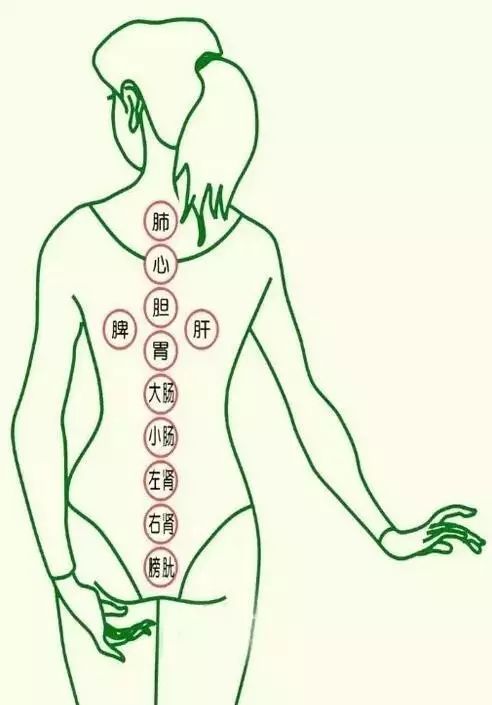 Cupping Acupoint Chart
Cupping Acupoint Chart
Lung Area Cup Marks
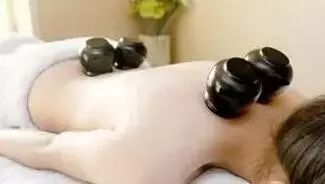
1. If purple-red spots appear on both sides during cupping, it indicates bronchitis.
2. If red patches appear during cupping, it indicates lung heat, with symptoms such as thirst and chest pain.
3. If small patches of rash appear during cupping, it indicates inflammation in the respiratory tract, such as pharyngitis or rhinitis.
4. If light purple or red appears, it indicates tonsillitis.
5. If light purple or red appears, it indicates lymphatic swelling.
6. If white appears, it indicates lung deficiency.
7. If pores are enlarged, it indicates wind invasion and exposure to wind-cold, with symptoms such as neck stiffness, shoulder pain, or shoulder periarthritis.
Heart Area Cup Marks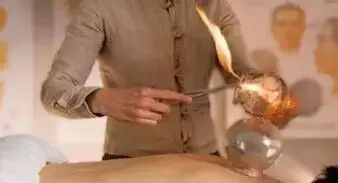 1. If connected purple-red marks appear, it indicates blockage in the heart meridian, which may cause chest tightness and shortness of breath.
1. If connected purple-red marks appear, it indicates blockage in the heart meridian, which may cause chest tightness and shortness of breath.
2. If small patches appear, it indicates insufficient blood supply to the brain, which may cause dizziness and a feeling of numbness in the head.
3. If purple-red stripes appear, it indicates cervical spine disease.
4. If white appears, it indicates myocardial ischemia.
5. If pores are widely opened and accompanied by mist, it indicates rheumatic heart disease.
6. If white appears, it indicates deficiency of qi and blood.
7. If there are depressions, it indicates insufficient heart blood, weak pulse, and shortness of breath.
8. If red appears, it indicates excessive heart fire.
Gallbladder Area Cup Marks

1. If small depressions appear, it indicates gallstones. 2. If purple-red spots appear around, it indicates dysfunction of gallbladder excretion, which may cause symptoms such as bitter taste in the mouth, rib pain, and jaundice. 3. If white appears, it indicates low gallbladder function. 4. If light purple circles appear, it indicates fear and timidity. 5. If patchy red rashes appear, it indicates cholecystitis.Liver Area Cup Marks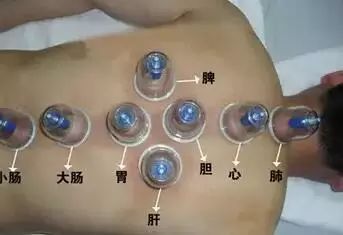 1. If reddish rashes appear, it indicates excess heat in the liver meridian, which may cause headaches, irritability, flushed face, yellow urine, and dry stools. 2. If the center of the cup mark is blue, it indicates hepatitis. 3. If light purple circles appear around, it indicates qi stagnation due to anger. 4. If purple circles appear, it indicates fatty liver. 5. If extensive reddish areas appear, accompanied by swelling and hardness, it indicates alcoholic liver disease. 6. If the entire liver area shows purple or purple-red, it indicates high blood viscosity. 7. If dark blue appears and is stiff, it indicates liver cirrhosis. 8. If dark blue spots appear with white interspersed, it may indicate liver ascites.Spleen Area Cup Marks
1. If reddish rashes appear, it indicates excess heat in the liver meridian, which may cause headaches, irritability, flushed face, yellow urine, and dry stools. 2. If the center of the cup mark is blue, it indicates hepatitis. 3. If light purple circles appear around, it indicates qi stagnation due to anger. 4. If purple circles appear, it indicates fatty liver. 5. If extensive reddish areas appear, accompanied by swelling and hardness, it indicates alcoholic liver disease. 6. If the entire liver area shows purple or purple-red, it indicates high blood viscosity. 7. If dark blue appears and is stiff, it indicates liver cirrhosis. 8. If dark blue spots appear with white interspersed, it may indicate liver ascites.Spleen Area Cup Marks

1. If reddish rashes appear, it indicates poor appetite or fullness in the ribs after eating, with loose stools and possible dizziness and fatigue. 2. If purple-red and raised marks appear, it indicates signs of spleen enlargement, accompanied by irritability and unstable temperament. 3. If red or reddish marks appear with enlarged pores, it indicates spleen damp-heat, chills, and spontaneous sweating. 4. If depressions appear, it indicates poor spleen function, weakness, sluggishness, and a tendency to be quiet. 5. If light purple or purple circles appear, it indicates qi stagnation and irritability. 6. If the entire area shows purple or purple-red, it indicates high blood lipids and high blood viscosity, possibly accompanied by high blood pressure.Stomach Area Cup Marks
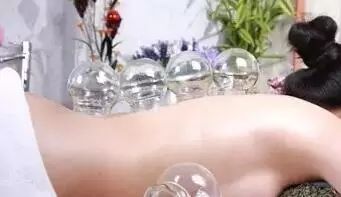
1. If reddish patches appear, it indicates stomach disease. 2. If the center is white, it indicates stomach cold disease, manifesting as stomach pain that worsens with cold. 3. If red appears, it indicates excess heat, poor appetite, and food stagnation. 4. If light purple circles appear, it indicates emotional distress. 5. If light purple circles appear around, it indicates superficial gastritis. 6. If dark purple circles appear around, it indicates chronic gastritis. 7. If depressions appear with light purple, it indicates atrophic gastritis. 8. If depressions appear with gray-white, it indicates poor stomach function and slow peristalsis, with reduced appetite and abnormal stools.Large Intestine Area Cup Marks

1. If purple-red cup marks appear, it indicates heat in the large intestine, which may cause dry stools or symptoms such as bad breath and dizziness. 2. If light purple circles appear, it indicates retained stool in the large intestine. 3. If white appears, it indicates wind-cold invasion, mainly in the abdomen. 4. If reddish marks appear with enlarged pores, it indicates damp-heat in the large intestine, poor digestion, frequent stools, or rapid bowel movements after meals. 5. If gray-white appears with depressions, it indicates slow peristalsis in the large intestine, or constipation occurring every three to five days, accompanied by dry stools. 6. If red spots appear, it indicates enteritis; if purple spots appear, it indicates chronic enteritis; if light purple spots appear, it indicates a history of enteritis.Small Intestine Area Cup Marks

1. If purple-red spots appear, it indicates dysfunction of the small intestine, mainly manifesting as abnormal urination and defecation, abdominal cramps, and bloating. 2. If white appears with enlarged pores, it indicates wind-cold invasion, mainly in the abdomen, accompanied by bowel sounds and gas. 3. If gray-white appears with depressions, it indicates slow peristalsis in the small intestine. 4. If purple-red spots appear, it indicates enteritis. 5. If dark red circles appear, it indicates ulceration. 6. If dark purple appears, it indicates toxins in the intestine. 7. If light purple spots appear, it indicates a history of inflammation. 8. If dark purple circles appear, it indicates constipation and retained stool.Kidney Area Cup Marks
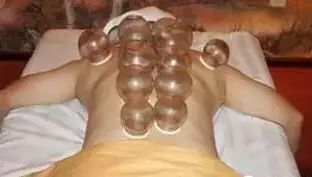
1. If purple-red spots appear, it indicates kidney qi instability, such as chronic nephritis, with frequent clear urination, nocturia, and soreness in the lower back and legs.
2. If white appears, it indicates kidney deficiency with water retention, severe swelling below the waist, and reduced urine output, with severe cases showing abdominal distension and scrotal swelling.
3. If small depressions appear, it indicates granular kidney stones; if white sand-like depressions appear, it indicates sandy kidney stones.
4. If pores are enlarged and do not fade, the left kidney indicates wind-cold in the lower back, while the right kidney indicates rheumatism in the leg joints.
5. If purple spots appear, it indicates past injuries to the lower back, such as sprains, bruises, or other trauma.
6. If internal purple or light purple circles appear, it indicates water retention in the kidney area.
7. If there is a significant color difference between the two kidneys, such as the left kidney being purple-red and the right kidney being gray-white, it indicates uncoordinated kidney function, with excess yang and deficient yin, or vice versa.
8. If both kidneys show purple-red and are accompanied by protrusions, it indicates hyperfunction.
Bladder Area Cup Marks
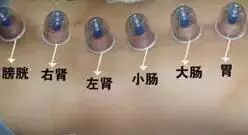
1. If purple-red bruises appear, in males, it indicates prostatitis, frequent urination, urgency, painful urination, or difficulty urinating; in females, it indicates menstrual irregularities and other gynecological diseases.
2. If purple-red spots appear with dull color, in males, it indicates prostate enlargement; in females, it indicates cervical erosion.
3. If purple-red spots appear in the lower area, it indicates hemorrhoids.
4. If the outer circle shows white and the inner circle is light purple, it indicates signs of diabetes; if the center is red, it indicates current exacerbation, with at least two symptoms present.
5. If peeling occurs, it indicates symptoms of chronic diabetes.
6. If the entire cup shows gray-white and has depressions, it indicates reduced sexual function.
7. If irregular light purple circles appear, it indicates past trauma and kidney dysfunction.
8. If dark purple spots appear in females, it indicates gynecological diseases, with the upper area indicating uterine diseases and the diagonal upper sides indicating appendiceal or ovarian diseases.
9. If light purple spots appear in females, it indicates uterine fibroids.
How to Adjust for Different Cup Mark-Related Body Issues?
1. If the cup marks are purple with patches, it indicates local cold and blood stasis. At this time, the patient should focus on dispelling cold. When eating, it is advisable to consume more scallions and ginger, and to keep warm.
2. If the cup marks show scattered purple dots, it indicates qi stagnation and blood stasis. At this time, the patient should focus on invigorating blood and qi, engaging in more exercise, or drinking rose tea.
3. If the cup marks are dark purple, it indicates blood stasis, such as dysmenorrhea or insufficient blood supply to the heart, and heavy cold exposure may also cause this mark. At this time, the patient should invigorate blood and break stasis, consuming more black fungus and onions.
4. If the cup marks are light purple with patches, it generally indicates a deficiency syndrome. If the spots are prominent at acupoints, it indicates weakness of related organs; for example, if it appears at the Shenshu (Kidney Back Shu) point, it indicates kidney deficiency. Targeted herbal treatment is needed.
5. If the cup marks are bright red, it generally indicates yin deficiency or deficiency of both qi and yin. At this time, the patient can tonify qi and nourish yin by consuming more chicken for qi, and more black sesame, yam, goji berries, grapes, and white fungus, while reducing smoking and alcohol consumption, and ensuring adequate sleep to nourish yin.
☞☞ Join the 【Beauty Industry Practitioners WeChat Group】 to exchange and learn with beauty professionals nationwide! Please click here
